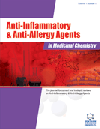- Home
- A-Z Publications
- Anti-Inflammatory & Anti-Allergy Agents in Medicinal Chemistry (Formerly Current Medicinal Chemistry - Anti-Inflammatory and Anti-Allergy Agents)
- Previous Issues
- Volume 7, Issue 1, 2008
Anti-Inflammatory & Anti-Allergy Agents in Medicinal Chemistry (Formerly Current Medicinal Chemistry - Anti-Inflammatory and Anti-Allergy Agents) - Volume 7, Issue 1, 2008
Volume 7, Issue 1, 2008
-
-
Nitric Oxide in Allergic Rhinitis
More LessBy Murat UnalNitric oxide (NO) is an important biological mediator and the exhaled form is mainly produced by the nose and paranasal sinuses. In the upper airways, NO has been suggested to involve in host defense, regulation of nasal airway flow and aerocrine messenger. It is now clear that many chronic sino-nasal diseases, including allergic rhinitis (AR), may alter the output of exhaled NO levels. AR is a chronic inflammatory disea Read More
-
-
-
Genetic Polymorphism in Allergic Rhinitis
More LessAuthors: Yusuf Vayisoglu and Murat UnalAllergic rhinitis (AR) is considered to be multifactorial inflammatory diseases involving complex interactions between genetic and environmental influences. Inflammatory reactions in AR are regulated by many cytokines. The impact of genetic factors on the pathogenesis of AR is currently an area of intense investigation. Various loci and candidate genes have been suggested to underlie allergy. Many or all are still controversia Read More
-
-
-
Mast Cell Stabilizers in the Treatment of Allergic Rhinitis
More LessAuthors: Ilknur H. Can and Ethem Erdal SamimAllergic rhinitis (AR) is caused by an immediate type hypersensitivity reaction in sensitized subjects after exposure to airborn allergens. The interaction of the allergen with a specific IgE antibody attached to the nasal mast cells leads to the local release of vasoactive and inflammatory mediators such as histamine, leukotriene C4 and prostaglandin D2. These mediators cause the nasal allergic symptoms complex of rhin Read More
-
-
-
Leukotrienes and Antileukotriene Therapy in Allergic Rhinitis
More LessBy Muge OzcanLeukotrienes (LT) are the inflammatory mediators that have an important role in inflammatory diseases such as allergic rhinitis and asthma. The leukotrienes that contain cystein, cysteinyl leukotrienes (Cys LTs), are LTC4, LTD4 and LTE4. They are synthesized from arachidonic acid by 5-lipooxygenase pathway and eosinophils and mast cells can produce large amounts of Cys LTs from an endogenous pool of arachidonic a Read More
-
-
-
The Role of Corticosteroids in Allergic Rhinitis Treatment
More LessBy Murat EnozThe goal of treatment in allergic rhinitis (AR) is to provide effective prevention of or relief from allergic rhinitis symptoms without adversely affecting daily activities or cognitive performance. Effective treatment of allergic rhinitis usually requires an integrated regimen that combines allergen avoidance measures, pharmacotherapy and possible specific- allergen immunotherapy. Oral corticosteroids are very effective Read More
-
-
-
Anti-Immunoglobulin E Treatment with Omalizumab in Allergic Diseases an Update on Anti-Inflammatory Activity and Clinical Efficacy
More LessBy I. OlcayOmalizumab is recently developed monoclonal anti-IgE antibody. Clinical trials have demonstrated its efficacy in patients with moderate-to-severe and severe or poorly controlled allergic asthma, in patients with seasonal and perennial allergic disease and in subjects with concomitant asthma and allergic rhinitis. Patients with more severe asthma appear to obtain the greatest benefit from omalizumab therapy. Omalizumab is Read More
-
-
-
Use of Antihistamines in Allergic Rhinitis
More LessAllergic rhinitis is a common immun-mediated inflammatory condition of the nasal mucosa. AR occurs because of the cross linking of IgE by allergens within the upper respiratory tract. Allergy is now understood to be a systemic inflammatory disease. The symptoms caused by this allergic inflammation include sneezing, rhinorrhea, nasal pruritus, and nasal congestion; allergic conjunctivitis often accompanies AR. The intera Read More
-
-
-
Treatment of Allergic Rhinitis in Children
More LessBy Gurkan KilicAllergic rhinitis is an inflammatory disease of nasal mucosa mediated by IgE-associated response to indoor and outdoor environmental allergens. The treatment of allergic rhinitis involves three main categories: avoidance of allergen, pharmacologic management and immunotherapy. The first therapeutic approach in allergic rhinitis is prevention, which is done by avoidance of causal allergens. This helps reduce the symptoms a Read More
-
-
-
Chemokines and Their Receptors as a Target for the Treatment of Contact Hypersensitivity
More LessAuthors: Yoshimi Niwano, Gaku Mitsui and Masahiro KohnoContact hypersensitivity (CHS) is an antigen-specific response elicited by exposure to certain low-molecularweight compounds termed haptens, and is the disease often seen clinically. CHS has also been used as a useful model to assess antigen-specific and T cell-dependent immune response. A wide variety of cells are thought to be involved in the pathogenesis of CHS. Keratinocytes and T cells are regarded as important factors, Read More
-
-
-
Antinflammatory Effects of Allergen Immunotherapy
More LessAuthors: Cristoforo Incorvaia, Marina Mauro, Andrea Rapetti and Franco FratiThe most common allergic diseases, such as rhinitis, asthma, and atopic dermatitis, are caused by inflammation induced by an immune response to environmental allergens, driven by regulatory cells such as antigen presenting cells and T lymphocytes with their secreted products of multiple activities - cytokines and chemokines - and sustained by effector cells such as mast cells, basophils, and eosinophils. Allergen immunoth Read More
-
Volumes & issues
-
Volume 24 (2025)
-
Volume 23 (2024)
-
Volume 22 (2023)
-
Volume 21 (2022)
-
Volume 20 (2021)
-
Volume 19 (2020)
-
Volume 18 (2019)
-
Volume 17 (2018)
-
Volume 16 (2017)
-
Volume 15 (2016)
-
Volume 14 (2015)
-
Volume 13 (2014)
-
Volume 12 (2013)
-
Volume 11 (2012)
-
Volume 10 (2011)
-
Volume 9 (2010)
-
Volume 8 (2009)
-
Volume 7 (2008)
-
Volume 6 (2007)
-
Volume 5 (2006)
Most Read This Month
Article
content/journals/aiaamc
Journal
10
5
false
en


